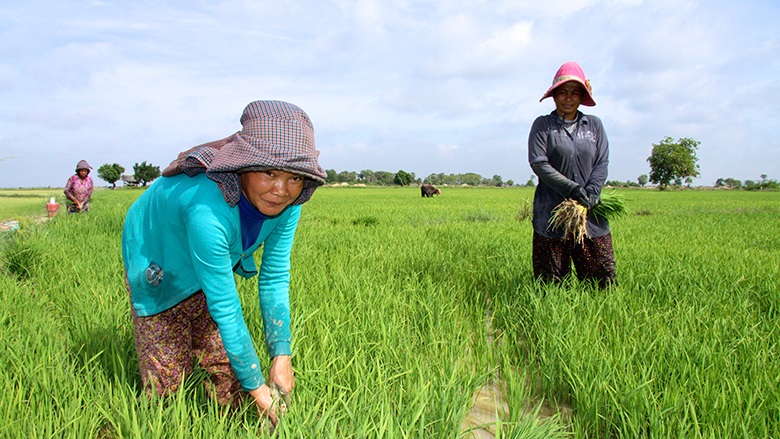Cambodian agriculture is in the midst of a rapid transformation. Agricultural growth averaged 5.3% during 2004-2012, which was among the highest in the world.
Growth was driven by a combination of increased yields, more productive use of labor due to mechanization, and the expansion of farmland.
Yet, agricultural growth has slowed down to around 1-2% in 2013-2014. A World Bank report, Cambodian Agriculture in Transition: Opportunities and Risks , co-financed by the World Bank and Australian Government, raises concerns and suggests ways to ensure agriculture continues to be a driver of growth and poverty reduction.
Key Findings
- Cambodia’s agricultural gross production grew by 8.7% during 2004-2012 mainly because of higher paddy rice production. There was also significant increase in maize (20%), cassava (51%), sugarcane (22%), and vegetables (10%) production, albeit from the low initial base.
- Cambodia’s poverty headcount declined from 53% in 2004 to 18% in 2012, lifting four million people out of poverty. More than 60% of poverty reduction was a result of positive developments in the agriculture sector.
- Farm wages grew by 206% (non-farm wages up 60%) in 2005-2013, converging with salaries in other sectors.
- Although farmers focused on growing paddy rice, a mix of more profitable aromatic paddy and non-rice crops was introduced. The total area under rice declined from 86% in 2002 to 74% in 2011 responding to the higher profits of other crops.
- Vegetables were the most profitable crops to produce in Cambodia. They were followed by cassava, maize, dry season rice, and wet season rice.
- Yields increased by 4% for most crops during 2004-2012. This was driven by the use of new technologies and quality fertilizers, expanded irrigation, and better access to mechanized services and markets.
- Agricultural exports increased as prices remained competitive compared to rice producers in neighboring Thailand, Vietnam and Myanmar.
Challenges
- A large share of past agricultural growth was driven by the expansion of cultivated area. On average, farmland increased annually by 4.7% over 2004-2012, and may have reached its limits.
- Per hectare profitability grew by 3.4%. Farmers who managed to expand their land holding made significant profits.
- On the other hand, the productivity of most small farms remained low. Although these farms increased their income, it was achieved through higher rice prices and from wages earned outside of their own farms.
- The number of vulnerable people has increased. Most people who escaped poverty did it by a small margin. The loss of only 1,200 Riels per day ($0.7) would cause a doubling of Cambodia’s poverty rate back to 40%.
- Since 2013, Cambodia’s rice production has flattened. This was due to the deceleration in land expansion, bad weather, falling global rice prices, and the tightening of competition among rice producers.
- Agricultural growth slowed down to below 2% in 2013-2014. At least 5% agricultural growth over the next 15 years is needed to keep real farm incomes growing. With 5% growth, farm wages are projected to triple from $1,200 currently to $3,760 in 2030. On the other hand, the agricultural growth of 3% would increase incomes only to $2,500 by 2030.
Recommendations
Investments and policy improvements are needed immediately. Some of these will take more time and effort to have an impact on the ground. These four policies can help support continued agricultural growth during the next five years (short-to medium term):
- Maintain a private sector friendly policy environment, particularly to reduce the regulatory burden in farm input sectors such as seeds and fertilizers.
- Strengthen the environmental sustainability of agricultural production.
- Improve the quality of agricultural public programs and increase allocations to more effective programs.
- Help develop the agribusiness and agro-processing industry.

